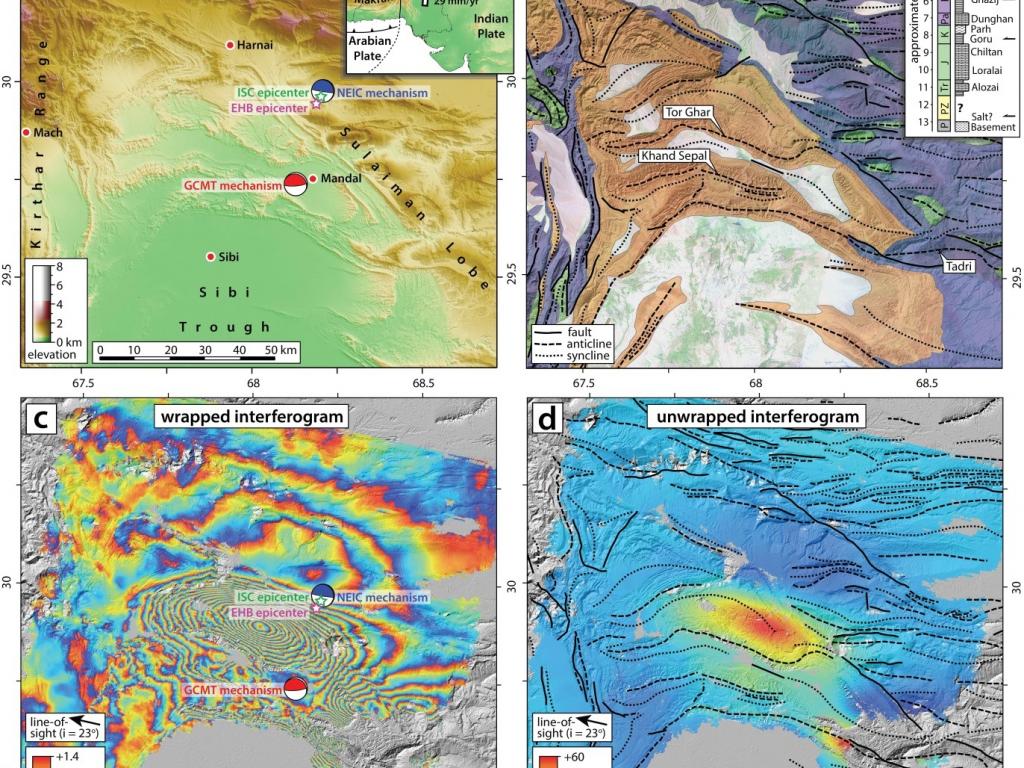Seismology: Remote-controlled earthquakes

Dr Alistair Sloan, who recently joined the Department of Geological Sciences at UCT was recently involved in studying an unusually large earthquake which occurred in Pakistan. The international team used a wide variety of methods from seismology to satellite radar technology to reveal that the earthquake actually involved two ruptures separated by 50 km and 19 seconds. The team suggest that the second rupture was triggered by passing seismic waves of the first. This type of dynamic cascading rupture is not considered in modern seismic hazard analyses, and can significantly increase the area effected by strong shaking and associated damage.
Seismologists are often asked whether a large earthquake can trigger a similarly sized event elsewhere on the planet. This question is difficult to answer quantitatively because the details of earthquake triggering are not completely understood. Fault rupture permanently alters static stresses in the surrounding crust, leading to more earthquakes — often observed as local aftershocks. Additionally, as seismic waves from an earthquake travel around the globe, they generate transient changes in stress that can promote small earthquakes dynamically, sometimes at distances far from the initial event. Regardless of the triggering mechanism, if two earthquakes occur close enough together in time and space, they will be hard to distinguish because it is difficult to isolate the second event from the seismic waves of the first.
In a recently published article in Nature Geoscience, Dr Sloan and colleagues analysed earthquakes in Pakistan and Chile — each listed in global earthquake catalogues as single events — and show that both involved multiple episodes of slip, on independent faults, separated by a small distance and short amount of time.
In one study that Dr Sloan was involved in, they used satellite-based geodetic data to analyse the characteristics of the magnitude 7.1 Harnai earthquake that occurred in Pakistan in 1997. These satellite interferograms, which map surface deformation, reveal two distinct patterns of faulting rather than a single lobe of deformation typically generated by slip on an individual fault. The researchers used analyses of seismic data to show that the two deformation lobes were indeed not caused by one, but by two distinct and similarly sized earthquakes, 50 km and 19 seconds apart. Furthermore, they show that static stress transfer from the first event at the location of the second was insufficient to trigger the latter earthquake. The triggering mechanism may have therefore been dynamic, related to the passage of seismic waves from the earlier rupture.
In a second study, Hicks and Rietbrock analysed seismic data associated with the 2011 magnitude 7.1 Araucania earthquake — a large aftershock of the 2010 Maule earthquake in Chile. They found that the earthquake was composed of slip on two different faults: slip on the thrust fault that makes up the subduction zone plate interface was almost immediately followed by slip on a fault in the overriding plate. The second event was 30 km and 12 seconds removed from the first, and amounted to a distinct magnitude 6.7 earthquake — slightly smaller than the triggering event. Similar to Nissen and colleagues, they suggest the second earthquake could have been triggered by the passage of seismic waves from the first.
For both the Chile and Pakistan earthquakes, the distance between the two faults that slipped surpassed the 5 km limit for multiple-fault ruptures assumed in some standard seismic hazard assessments. The studies suggest that the passage of seismic waves can almost instantaneously trigger secondary events beyond the rupture area of the first earthquake, increasing the region of significant shaking and thus the associated potential impact on population and infrastructure. This different class of dynamic, cascading rupture has not been considered in modern hazard analyses, and as such related hazards may be underestimated in regions of complex faulting.
Observationally, these studies reveal that we now have the tools to identify earthquake complexity at a level that has not been possible in the past. With the extensive availability of high-quality broadband seismic data at both global and regional scales, the systematic and regular collection of satellite imagery, and the expansion of real-time GPS networks, observations of faulting and related ground deformation are becoming more widespread, and the resolution is higher than ever before. Together with studies of other complex earthquakes, such analyses are paving the way toward routine and real-time identification in the future.
The processes that drive complex ruptures remain unclear, as do the details of earthquake triggering. However, Nissen and colleagues and Hicks and Rietbrock show that improved observational capacities can make it possible to distinguish between continuous earthquake rupture on a single fault, and separate but temporally and spatially proximate events. A goal now must be to understand what the implications of these complex earthquakes are for seismic and tsunami hazards, and how they can be considered in hazard assessments of the future.